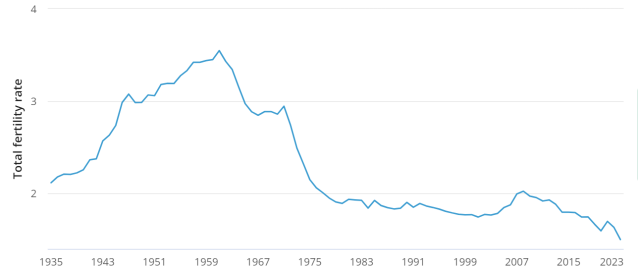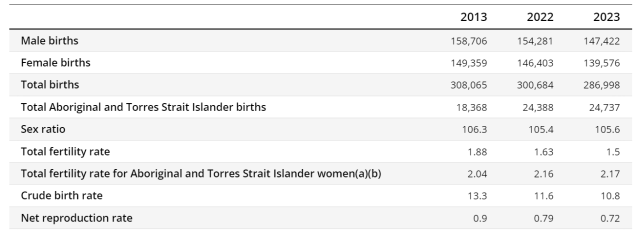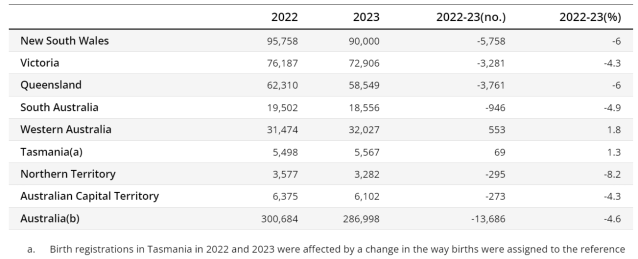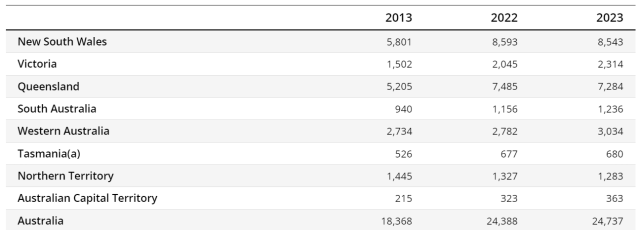Australia recorded a historically low fertility rate in 2023, latest government figures show.
Released by the Australian Bureau of Statistics, the country’s births data reveals Australia’s total fertility rate in 2023 was 1.50 babies per woman in 2023 – lower than 2022 (1.63), remaining lower than 2013 (1.88), and far lower than 1961 (3.55).

“The record low total fertility rate is because there were fewer births in most states and territories,” ABS head of demography statistics Beidar Cho said.

The data shows that Australia is unlikely to replace the current generation. As the bureau acknowledges: “The total fertility rate level required for replacement is currently considered to be around 2.1 babies per woman to replace herself and her partner in the absence of overseas migration.”
The decline in total fertility rate was most prominent among women aged 15-19 years where the age-specific fertility rate fell by more than two-thirds. The fertility rate of women aged 20-24 also saw a large decline.
In contrast, the age-specific fertility rate of women aged 40-44 years almost doubled (to 15.1 per 1,000 women) when compared with 30 years ago. Meanwhile, women aged 30-34 years continue to have the highest age-specific fertility rate (105.2 babies per 1,000 women), followed by women aged 25-29 years (74.9 babies per 1,000 women).
“The long-term decline in fertility of younger mums as well as the continued increase in fertility of older mums reflects a shift towards later childbearing,” Cho said. “Together, this has resulted in a rise in median age of mothers to 31.9 years, and a fall in Australia’s total fertility rate.”
Overall, there were 286,998 registered births in Australia in 2023 – a decrease of 4.6% in 2022.

There were 147,422 male births during the period and 139,567 female births – a sex ratio of 105.6 male births per 100 female births.
As the ABS stats show, most states and territories recorded a decrease in birth registrations in 2023.

Crunching the numbers, ABS analysts found the largest proportional decreases in registered births in each state and territory were:
- Northern Territory (-8.2% or 295 births)
- New South Wales (-6.0% or 5,758 births)
- Queensland (-6.0% or 3,761 births)
- South Australia (-4.9% or 946 births).
Western Australia, meanwhile, recorded the most births (1.8 or 553 births).

There were 24,737 Aboriginal and Torres Strait Islander births registered in 2023, an increase of 349 babies from 2022, “which makes up 8.6% of all births”, Cho said.
- NSW and Queensland recorded the highest number of births (8,543 and 7,284)
- ACT recorded the lowest number of births (363).
At 2.17 babies per woman, the total fertility rate for Aboriginal and Torres Strait Islander women was higher than for all Australian women.
The fertility rate could be supported through better access to affordable childcare
Professor Peter McDonald
Commenting on the ABS data, Peter McDonald – professor of demography at the University of Melbourne – told Government News it was important to remember the information is based on the number of births registered in 2023, not the number of births that actually occurred. “Because state registrars are often slow in providing data to the ABS, it is risky using registered births to describe annual trends in fertility,” he said.
“Nevertheless,” added McDonald, “with some bumps, the fertility rate in Australia has been falling for the past 50 years because women have been delaying the commencement of childbearing to increasingly older ages. Then some delayed births never happen.”

McDonald told GN that this trend must end at some point. “If the delay of births ceases, the fertility rate will level off probably around its present level. It is possible however that intentions will change through a higher percentage of women having no children. If that were to occur, the fertility rate would fall quickly to about 1.2.”
This would lead government to take steps, said McDonald. “The fertility rate could be supported through better access to affordable childcare and affordable housing. Don’t be surprised to see the parties offering childcare packages for the next election.”
However, McDonald told GN that if the focus shifts from the rate of fertility to the number of births, concern will be lowered “because migrants add substantially to the childbearing population and hence to the number of births. With permanent migration around 200K per annum, births will exceed deaths for decades into the future.”





Leave a Reply